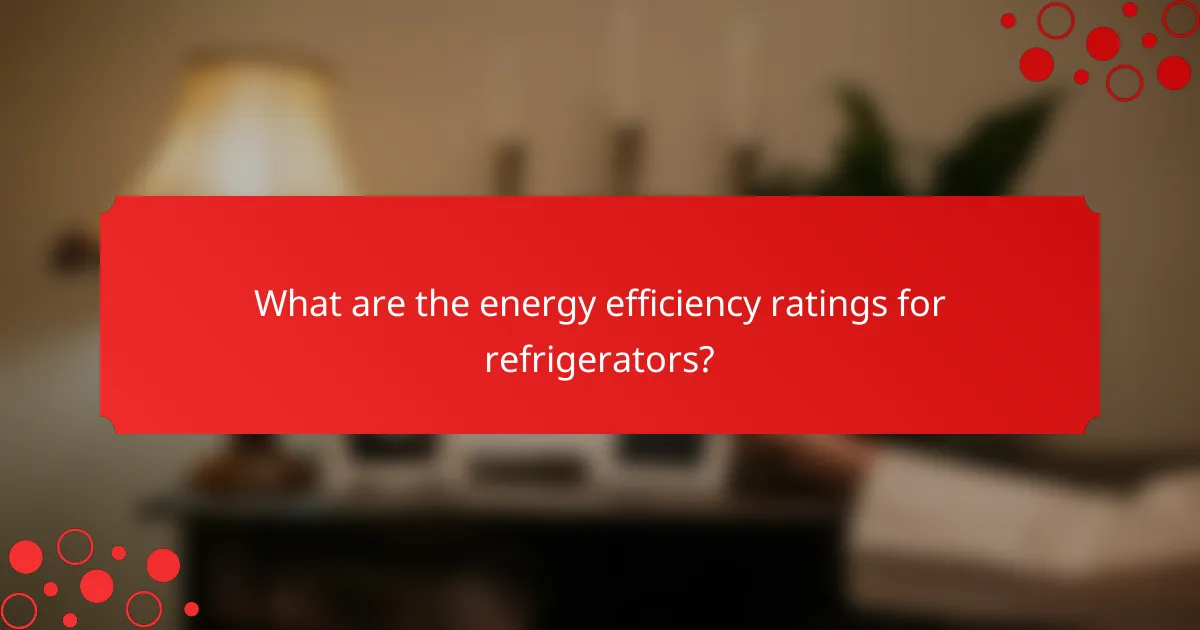When considering a new refrigerator, it’s important to note that the average price range in the US typically falls between $500 and $3,000, influenced by factors such as brand, size, and features. Installation costs generally range from $100 to $300, depending on labor and any necessary modifications. Additionally, annual maintenance expenses usually amount to $100 to $200, ensuring the appliance operates efficiently over time.

What is the average price range for refrigerators in the US?
The average price range for refrigerators in the US typically falls between $500 and $3,000. This range varies based on several factors, including brand, size, and features.
Average price range: $500 – $3,000
Refrigerators can be found at various price points, with basic models starting around $500. Mid-range options usually cost between $800 and $1,500, while high-end models can exceed $2,500, depending on their advanced features and technology.
When budgeting for a refrigerator, consider not just the purchase price but also potential delivery and installation fees, which can add a few hundred dollars to the total cost.
Factors affecting price: brand, size, features
Brand reputation plays a significant role in the pricing of refrigerators. Well-known brands often charge a premium for their products due to perceived reliability and customer service.
Size is another critical factor; larger refrigerators generally cost more. Additionally, features such as smart technology, energy efficiency ratings, and specialized compartments can significantly influence the price.
Popular brands: Whirlpool, Samsung, LG
Whirlpool, Samsung, and LG are among the most popular refrigerator brands in the US. Whirlpool is known for its reliability and straightforward designs, while Samsung offers innovative features and smart technology.
LG is recognized for its stylish designs and energy-efficient models. Each brand has a range of options, catering to different budgets and preferences, making it essential to compare models before purchasing.

What are the installation costs for refrigerators?
The installation costs for refrigerators typically range from $100 to $300, depending on various factors. These costs can include labor, materials, and any necessary modifications to your kitchen space.
Typical installation cost: $100 – $300
The average cost for refrigerator installation falls between $100 and $300. This price range covers professional installation services, which may include delivery, setup, and disposal of the old unit. In some cases, additional fees may apply for specialized installations, such as built-in models.
Factors influencing installation cost: location, complexity
DIY installation options available

What are the maintenance expenses for refrigerators?
The maintenance expenses for refrigerators typically range from $100 to $200 annually. Regular upkeep is essential to ensure optimal performance and longevity of the appliance.
Average annual maintenance cost: $100 – $200
The average annual maintenance cost for refrigerators generally falls between $100 and $200. This cost can vary based on factors such as the refrigerator’s age, brand, and frequency of service. Budgeting within this range can help homeowners prepare for routine maintenance and unexpected repairs.
Common maintenance tasks: cleaning coils, checking seals
Common maintenance tasks for refrigerators include cleaning the condenser coils and checking the door seals. Cleaning coils, typically located at the back or underneath the appliance, helps improve energy efficiency and cooling performance. Checking seals ensures that the refrigerator maintains proper temperature by preventing cold air from escaping.
Professional service options: local appliance repair services
For more complex maintenance tasks or repairs, homeowners can rely on local appliance repair services. These professionals can perform thorough inspections and repairs, often providing warranties on their work. It’s advisable to research and choose a reputable service provider to ensure quality and reliability in maintenance and repairs.

What are the energy efficiency ratings for refrigerators?
Energy efficiency ratings for refrigerators indicate how effectively a unit uses electricity. These ratings help consumers understand potential energy savings and environmental impact, with higher ratings generally signifying lower energy consumption.
Energy Star certification benefits
Refrigerators with Energy Star certification meet strict energy efficiency guidelines set by the U.S. Environmental Protection Agency. These models typically use 10-50% less energy than standard models, leading to significant savings on electricity bills over time.
Additionally, Energy Star appliances often come with rebates and incentives from local utilities, making them a financially attractive option. Choosing an Energy Star certified refrigerator can also contribute to a reduced carbon footprint, benefiting the environment.
Impact on long-term costs
The long-term costs of operating a refrigerator are heavily influenced by its energy efficiency rating. A more efficient model may have a higher upfront cost but can save hundreds of dollars in energy bills over its lifespan, which typically ranges from 10 to 20 years.
When selecting a refrigerator, consider the estimated annual operating costs provided by the manufacturer. Comparing these figures can help you make an informed decision, ensuring that you balance initial investment with future savings effectively.

What features should I consider when buying a refrigerator?
When buying a refrigerator, consider size, type, energy efficiency, and additional features like smart technology. These factors will influence not only the appliance’s functionality but also its compatibility with your kitchen space and lifestyle.
Essential features: size, type (French door, side-by-side)
Size is crucial; ensure the refrigerator fits your kitchen layout and meets your storage needs. Measure the available space and consider how much food you typically store.
Types of refrigerators include French door, side-by-side, top-freezer, and bottom-freezer models. French door refrigerators offer wide shelves and easy access, while side-by-side models provide convenient access to both fresh and frozen items but may have narrower storage spaces.
Smart technology options: Wi-Fi connectivity, app control
Smart refrigerators come with Wi-Fi connectivity, allowing you to control settings remotely via a smartphone app. This feature can help you monitor temperatures, receive alerts, and even manage grocery lists.
When considering smart technology, weigh the benefits against the cost. While these models can be pricier, they may offer energy savings and enhanced convenience, making them a worthwhile investment for tech-savvy households.

How do refrigerator prices compare across different brands?
Refrigerator prices vary significantly among brands, influenced by features, size, and technology. Generally, well-known brands like Whirlpool and Samsung offer a range of models that cater to different budgets, from affordable to high-end options.
Price comparison: Whirlpool vs. Samsung
Whirlpool refrigerators typically range from around $600 to $2,000, depending on the model and features. They are known for their reliability and straightforward designs, making them a popular choice for budget-conscious consumers.
In contrast, Samsung refrigerators often start at a similar price point but can go up to $3,500 or more for advanced models with smart technology and premium finishes. Samsung’s offerings are recognized for innovative features, such as touchscreen interfaces and energy-efficient designs.
When comparing these brands, consider what features are most important to you. If you prioritize reliability and simplicity, Whirlpool may be the better choice. However, if you want cutting-edge technology and design, Samsung could be worth the investment.



